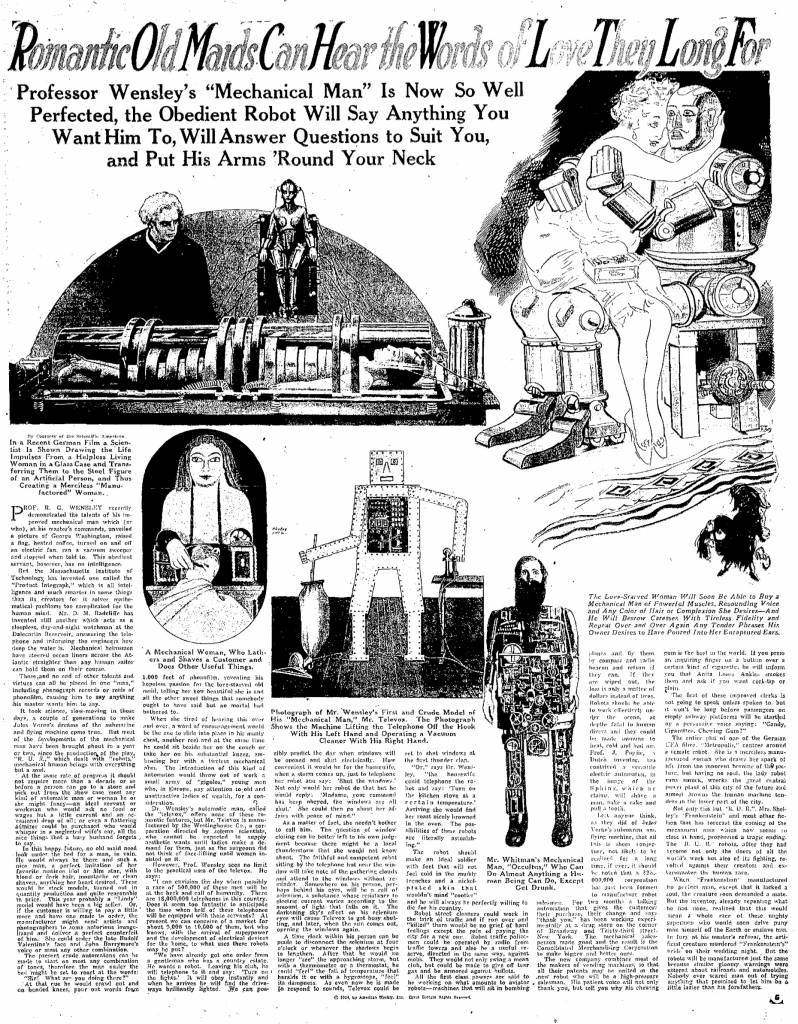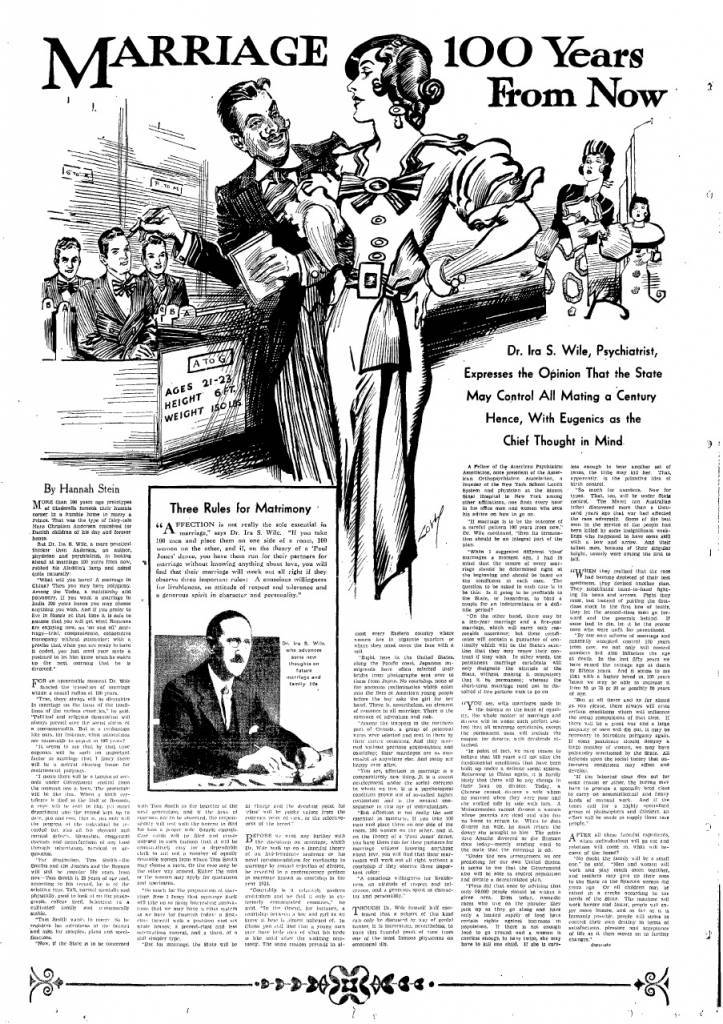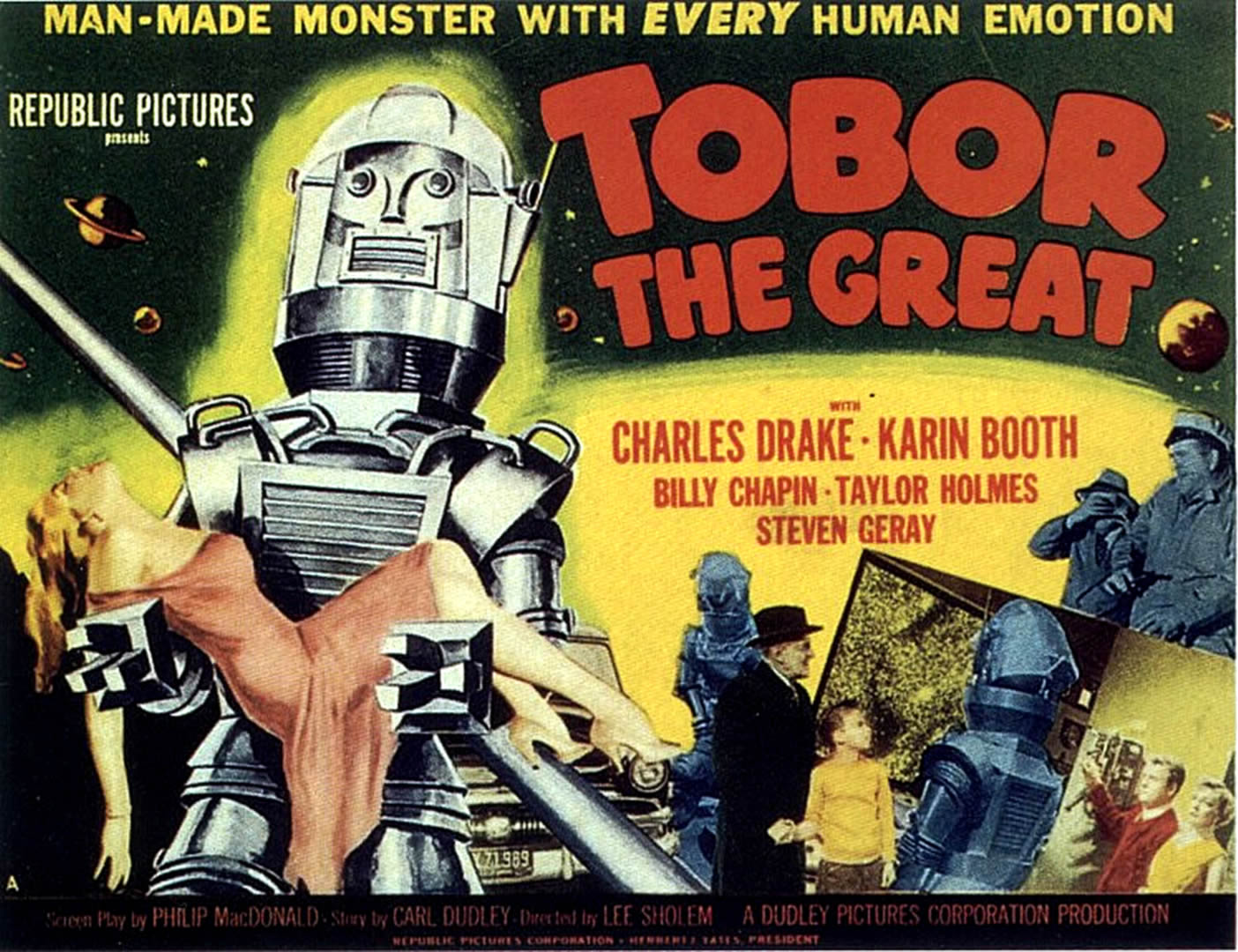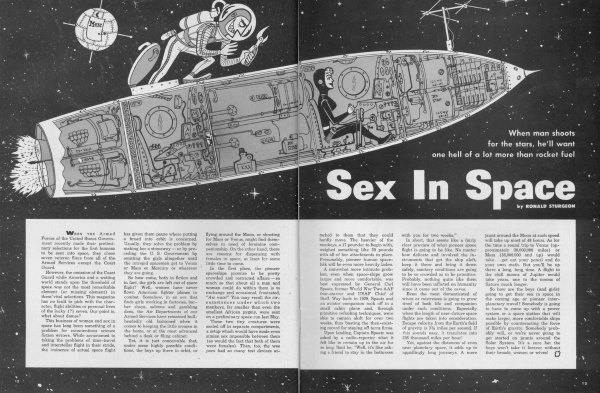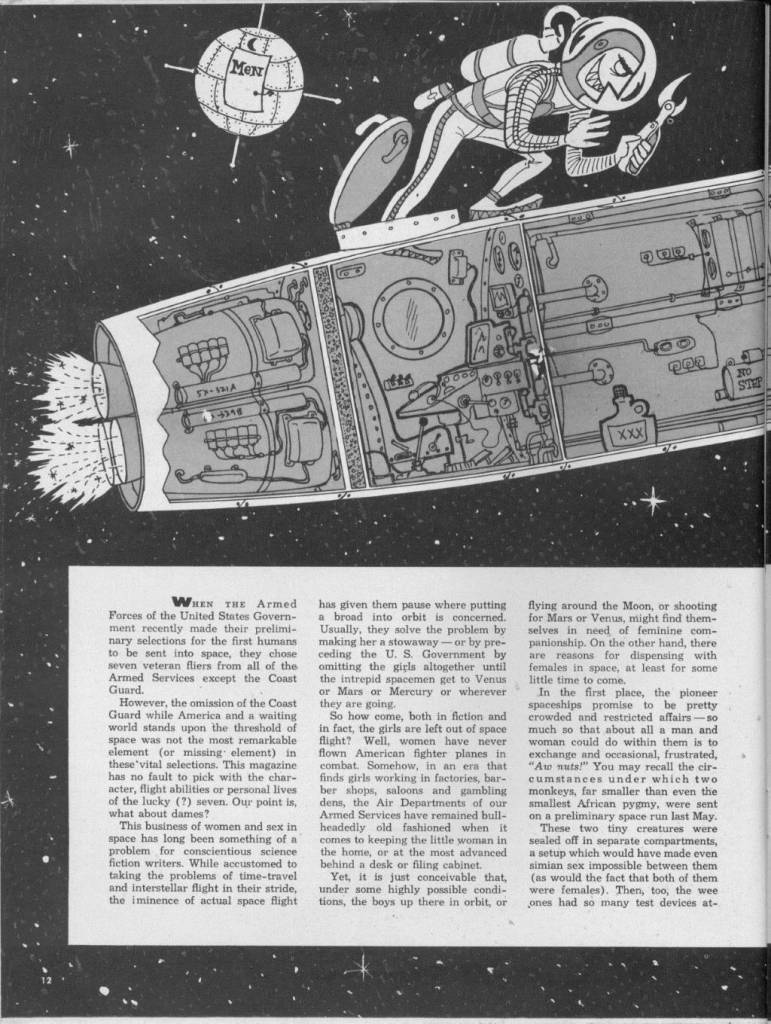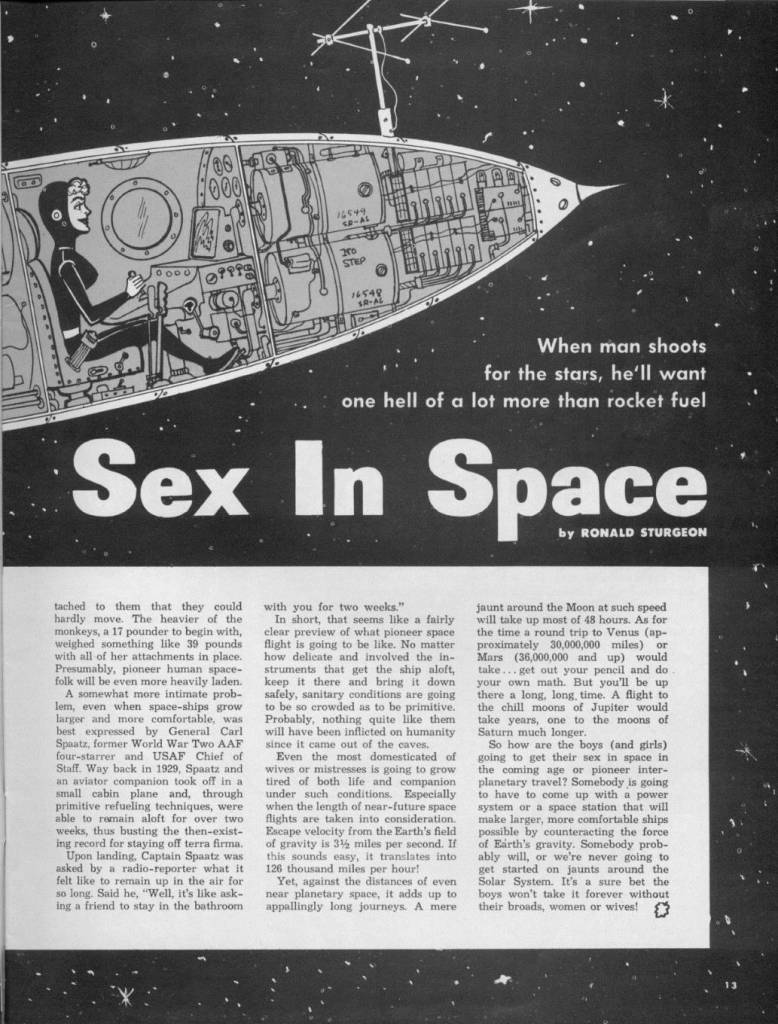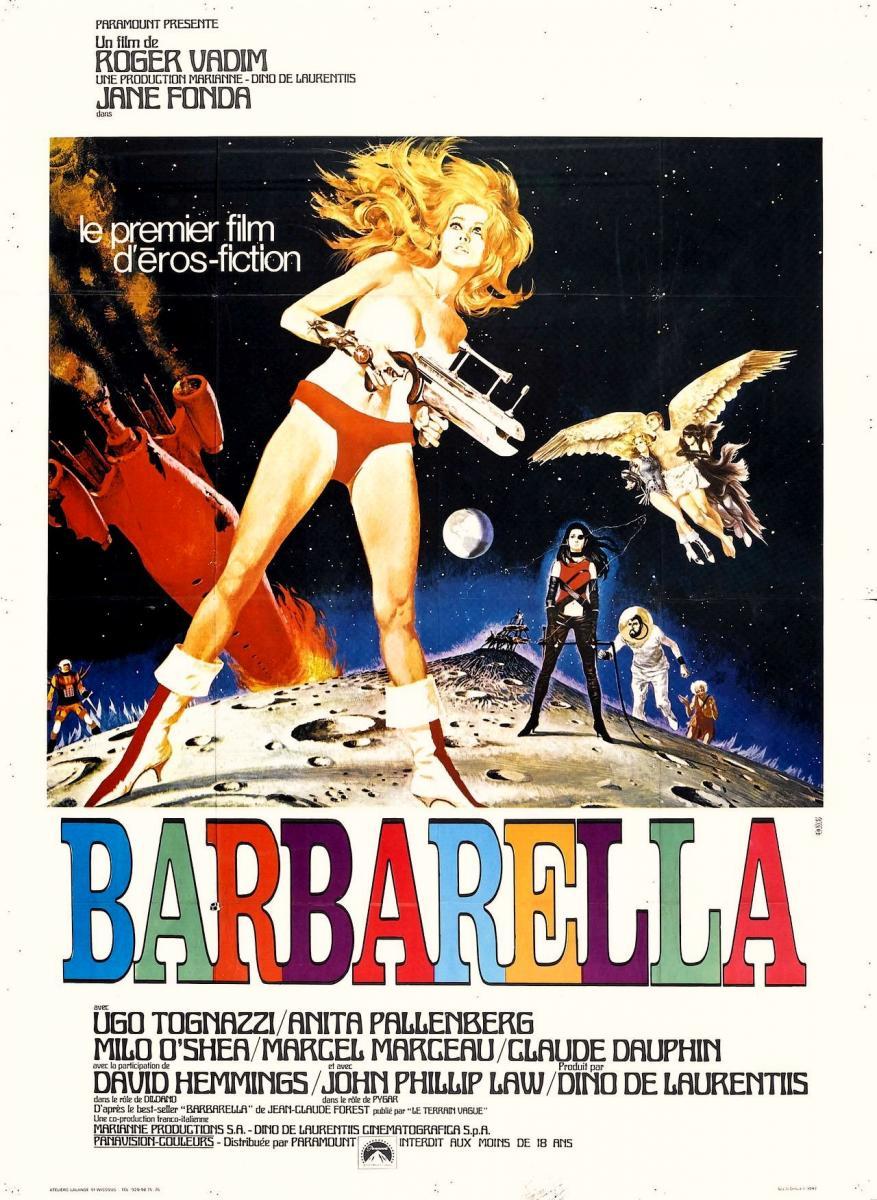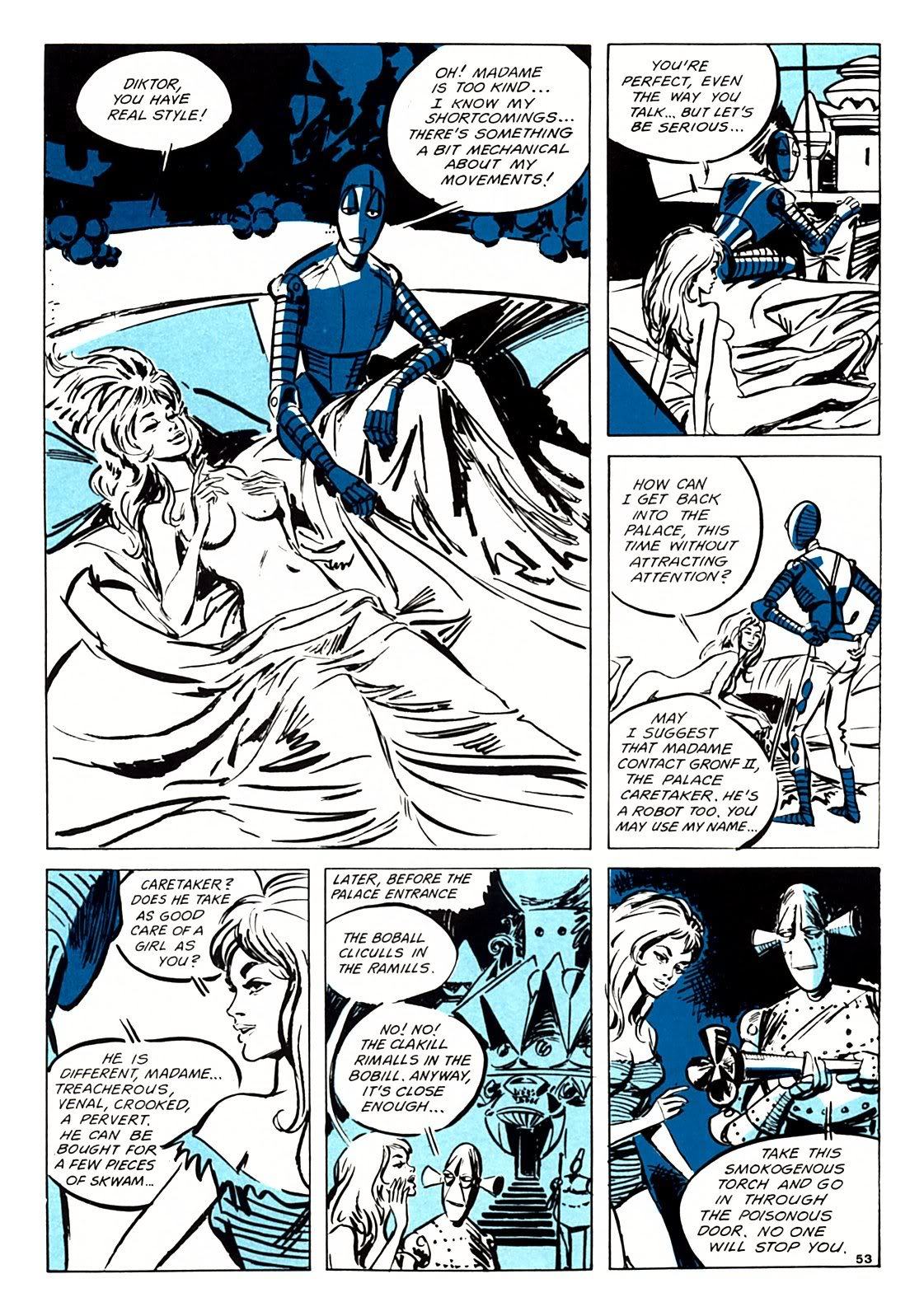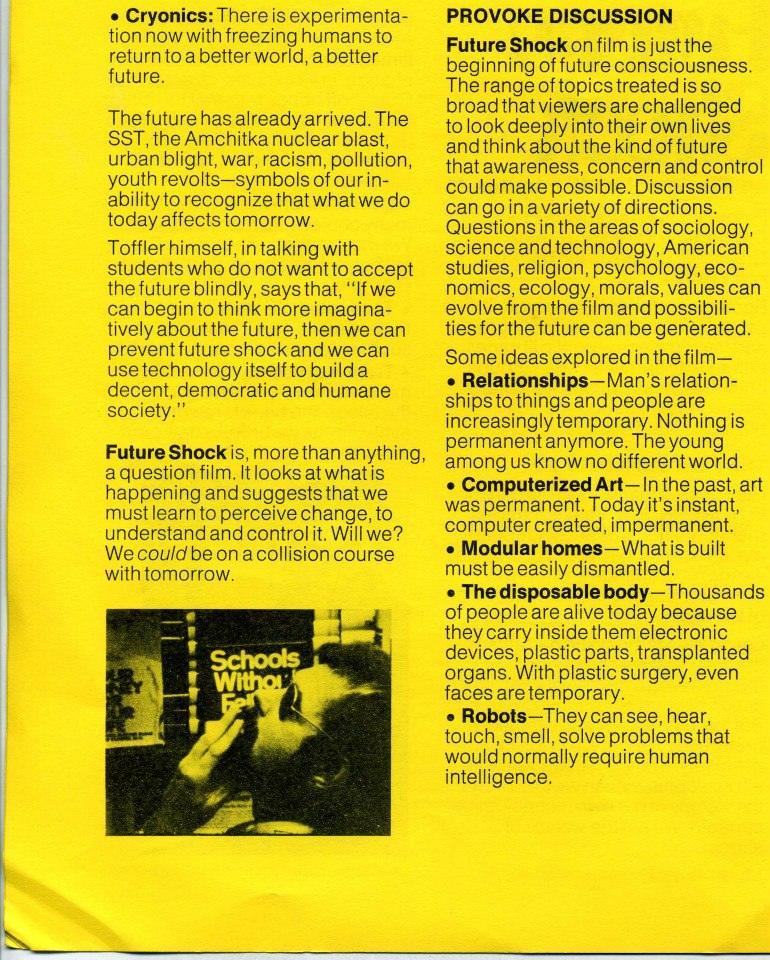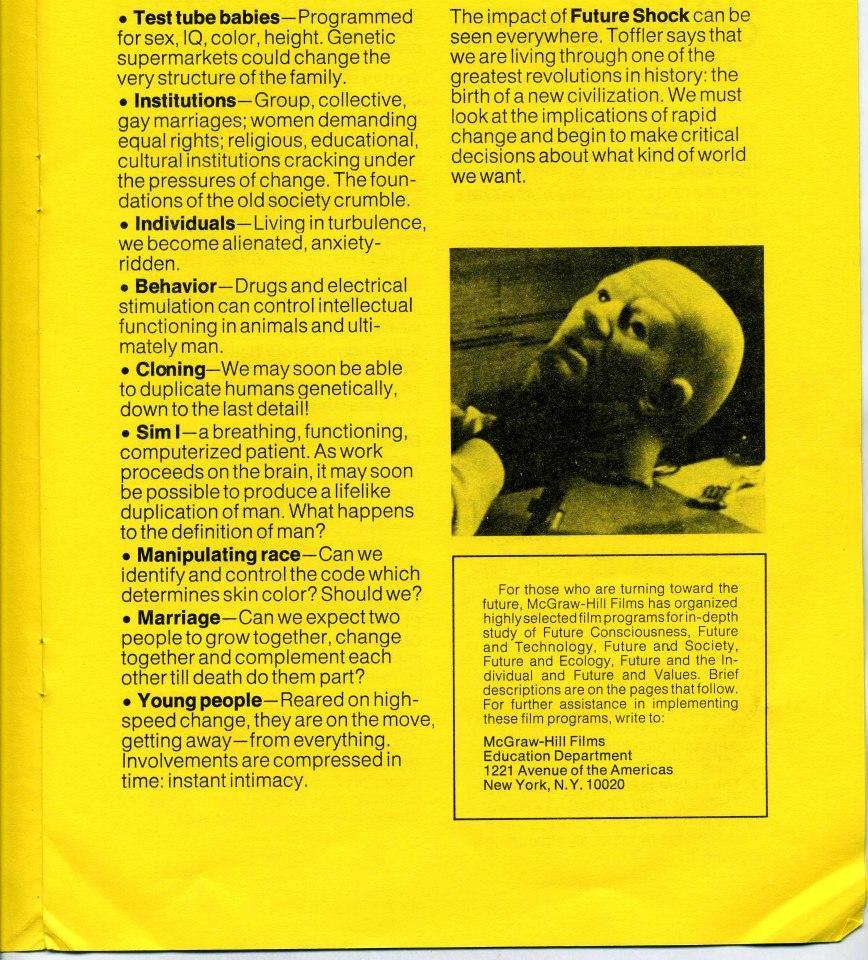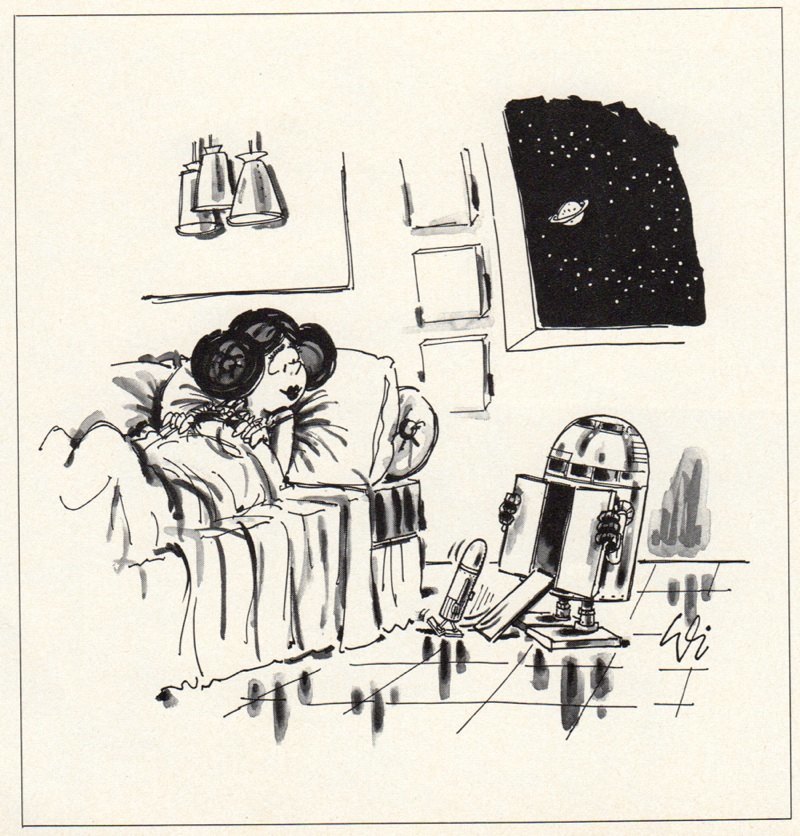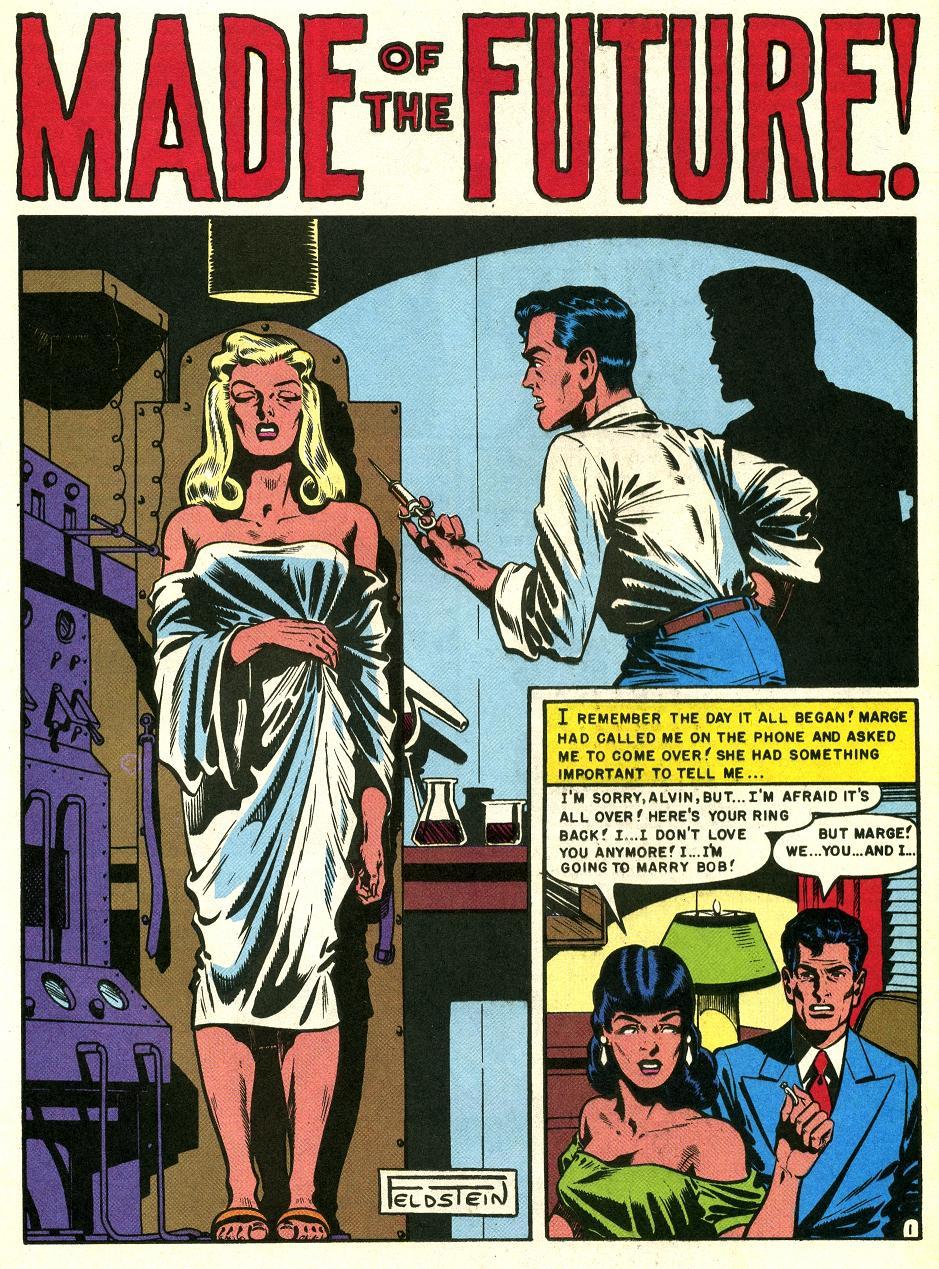The saying goes that every generation likes to think it invented sex. In the 20th Century, fine minds went one stage further: they reinvented it. Last year Middlesex University published a survey that showed a staggering 46% admitting that they’d either get it on with a sexbot or not judge those who wanted to. Professor Martin Smith, who was in charge of the project, makes a case for future droids becoming quasi-sentient—with pre-programmed sentience, “Robots will be able to show most, if not all, of the signs and behaviours of emotional intelligence…The robots will not feel, but like actors they will be able to show emotional intelligence.” In this Flashbak, we look at future sex, how human being would be at it and not at it in the 21st Century and beyond.
1928: The Old Maid’s Robot
On July 1, 1928, the San Antonio Light treated readers to Romantic Old Maids Can Hear the Words of Love They Long For – the story of a spinster with a male robot gigolo under her bed. The beard is optional. Mechanical Man will obey your every command.
1933: It;s 2033 and the State controls all ‘mating’
Ira S. Wile had a vision of the future for the June 25, 1933, issue of the Oakland Tribune. In 2033 the State is controlling “all mating”. If you think that’s weird, it wasn’t back then, when H.G. Wells, Helen Keller and Winston Churchill were all favour of eugenics.
1956: Elektro will join you in post-coitus smoke
After Elektro and his dog Sparko wowed the 1939 New York World’s Fair they toured Westinghouse retailers. The above advert ran in the July 2, 1956 San Mateo Times. He ‘walks, talks, smokes, sings’. Phwoar!
Can this man-sized robot man be tamed? Are women safe? Do they want to be safe?
1959: Adam magazine publishes Sex in Space, written by Ronald Sturgeon.
(Via NeonBubble)
He seems nice:
This business of women and sex in space has long been something of a problem for conscientious science fiction writers. While accustomed to taking the problems of time-travel and interstellar flight in their stride the iminence [sic] of actual space flight has given them pause where putting a broad into orbit is concerned. Usually, they solve the problem by making her a stowaway – or by preceding the U.S. Government by omitting the girls altogether until the intrepid spacemen get to Venus or Mars or Mercury or wherever they are going.
So how are the boys (and girls) going to get their sex in space in the coming age or [sic] planetary travel? Somebody is going to have to come up with a power system or a space station that will make larger, more comfortable ship possible by counteracting the force of Earth’s gravity. Somebody probably will, or we’re never going to get started on jaunts around the Solar System. It’s a sure bet the boys won’t take it forever without their broads, women or wives!
1967: The Mystery of Life
The Mystery of Life was broadcast by CBS on February 26, 1967. Walter Cronkite was seen in conversation with eugenicist James Bonner.
Bonner: Each baby, when it’s born, must donate some of his sex cells, sperm or eggs, and these are put in a deep freeze and just kept. The person leads his life, and dies. And after he’s all dead and gone, so the heat of passion is taken out of the matter, a committee meets and studies his life.Cronkite: So during his lifetime then, he hasn’t had any children?
Bonner: He’s been sterilized, and hasn’t had any children in the normal way. After he’s dead and gone, the committee meets and reviews his life and asks, ‘Would we like to have some more people like him?’ If the answer’s no they take out his sex cells of the deep freeze and throw them away. But if the answer’s yes then they use him to fertilize eggs similarly selected on the basis of review and validation of a person’s contributions during his lifetime. He just doesn’t get to brazenly go out and propagate his own genes without assuring himself and everyone else that they’re the best possible genes.
1968: Jane Fonda is doing her bit for inter-species relations
Barbarella, based on comics of Jean- Claude Forest, featured Fonda on a shagathon:
In an unspecified future, Barbarella is assigned by the President of Earth to retrieve Doctor Durand Durand from the Tau Ceti region. Durand Durand is the inventor of the Positronic Ray, a weapon that Earth leaders fear will fall into the wrong hands. Barbarella crashes on the 16th planet of Tau Ceti and is soon knocked unconscious by two mysterious girls, who take Barbarella to the wreckage of a spaceship. Inside the wreckage, she is tied up and several children emerge from within the ship. They set out several dolls which have razor sharp teeth. As the dolls begin to bite her, Barbarella faints but is rescued by Mark Hand, the Catchman, who patrols the ice looking for errant children. While Hand takes her back to her ship, Barbarella offers to reward Mark and he suggests sex. She says that people on Earth no longer have penetrative intercourse but consume exaltation transference pills and press their palms together when their “psychocardiograms are in perfect harmony”. Hand prefers the bed, and Barbarella agrees. Hand’s vessel makes long loops around Barbarella’s crashed vessel while the two have sex, and when it finally comes to a stop, Barbarella is blissfully humming. After Hand repairs her ship, Barbarella departs and promises to return, agreeing that doing things the old-fashioned way is occasionally best.
She tires out the Excessive Machine.
Also 1968: ‘This Robot Can Make Love’
1969: In the distant future sex with Artificial Intelligence is the norm
In 1969 Brian Aldiss wrote Super-Toys Last All Summer Long. The book would become A.I., the 2001 American science fiction film directed by Steven Spielberg. But development of A.I. began with Stanley Kubrick in the early 1970s.
He had a vision for Rogue City, the place of sex (see above).
Robot or human, the interest in the shape or primary sexually characteristic never dims.
1970: Civilized Adultery
Albert Ellis’ looked at sex in his 1970 book Prophecy for the Year 2000.
What I call civilized adultery will exist a great deal more in the 21st century. People will agree with each other, husbands and wives, to have adulterous affairs from time to time quite above board instead of having them secretly behind each other’s backs. They will not get upset about these any more than lots of people in other societies in the past, and present, do not get upset about adulterous affairs.
See the, er, 1970s.
1972: Future Shock
Time to turn you and your lover into sexbots. The 1972 film of Alvin Toffler’s Future Shock shows a man of the future starting his day with IQ pills and anti-depressant electrical shocks.
A number of years from now, perhaps when a person gets up in the morning and has to take the drug to bring his IQ up to the appropriate level, slap on the battery pack so that whenever he gets depressed he can press a lever and turn on electrical stimulation which delights him a little bit.
The sex talk begins after 31 minutes. (But the entire film is well worth a watch):
1973: Woody Allen
It’s the year 2173 in Allen’s film Sleeper. Sex takes place in the Orgasmatron.
1974: porn, porn, porn and more porn.
Bob MacKenzie wrote about future sex and television in the February 3, 1974 Oakland Tribune titled, “A ‘Tomorrow’ Look At World Of TV.”
Malcolm Muggeridge, the ancient, acidic book critic writing in Esquire, likes to refer to “future historians . . . if there are any.”We must now consider the case of future television watchers, if there are any.
What will they watch, and on what?
…
At present the movie theaters are offering patrons what they can’t get on their home screens – bloody violence, nudity, sex, naughty words.
But even those never-failing attractions will be available on television in the future – if not in the regularly scheduled programs, then in cassette television. And, needless to say, Cassettes will bring the era of readily-available TV pornography. Whether that constitutes an advance for the civilized world the reader must decide for himself.
And as long as people persist in being human, television drama will concern the same subjects that drama has always treated: the timeless issues of love and faith and valor and ambition and loss, the yearnings of the heart and itchings of the glands.
1978: Penthouse investigates
The October 1978 issue of Penthouse magazine zooms in on Science and the Future. This feature served as an intro to OMNI, “a magazine of science, science fiction and the future”, run by Kathy Keeton, future wife of Penthouse publisher Bob Guccione.
SPACE: the final, full-frontal frontier… the last hurrah… to go where no man has ever gone before, the forbidden and yet insidiously alluring planet of NYMPHON in the second quadrant of PHI DELTA PUBIS, hard by the tumescent moons of GLUTEON MAXIMUS. It was here that I said good-bye to an intrepid friend, a great lady, whose heaving decks and smoldering afterburners had served me well — the Yenta Prize, peripatetic mistress of the cosmic seas. I beamed down… down into the swirling, choking vapors that envelop NYMPHON, down to the very floor of this curious planet where, unused to the dense, jellylike atmosphere, I passed out.
Star Wars robot R2-D@ packed a little ambulatory pal:
1982: buying love
It’s June 2, 1982 and the Washington Post is talking about lovebots. Stephanie Mansfield predicts:
He comes home every night, grabs a beer and falls asleep in front of the television. You might as well be married to a robot, you say. Well, by the year 2000, you could be.
He may even look like Cary Grant, talk about white-water rafting, be able to fix a drink and possibly even be good in bed,” says Arthur Harkins, director of the graduate program in futures research at the University of Minnesota.
“One of the things we’re seeing now is that people are shopping for other people the way they’d shop for an appliance,” he says, citing the proliferation of computerized dating services, explicitly worded personal want ads and marriage brokers. “You’re buying something that makes you happy.”
Domestic robot systems are expected to come on the market by the mid-1990s, according to Harkins, and sell for several thousand dollars. These highly sophisticated androids can be programmed to offer a wide range of human personality traits. (“We can even make them neurotic”) and are likely to be purchased by “people who have difficulty opening up to other human being,” he says.
These surrogate spouses would be beneficial to very lonely people.
But can you fall in love with a robot? “Why not?” says Harkins, citing a bedridden hospital patient. “Along comes this wonderful android who doesn’t care a bit about that, whereas other human beings may not be so inclined.”
The union between man and machine would not be recognized as legal, Harkins says, but perhaps could be treated as a common-law marriage. And there’s no question of a messy divorce. “Just trade it in, I suppose,” the scientist says.
Another example of future schlock was the robot pets offered by Neiman-Marcus last Christmas, which Harkins says only strengthens his theory that people today want certainty. “They want somebody predictable,” he says.
But Harkins says he doesn’t want to trade in his own wife for a robot — just yet. Not even, he fantasizes, “a Margot Kidderrobot.”
“I’d be bored stiff,” he says. “But I may get to be 70 years old and look at a Mae West robot with a great deal of interest.”
1986: position vacant
In 1986 Arthur C. Clarke writes July 20, 2019: Life in the 21st Century. Sex is free and easy – people “boldly state their desires, no matter how bizarre or specific.” He predicts an advert:
Married white female, 40, seeks well-endowed SWM, 18-28, for 3-month intimate companionship. My husband’s hormone treatments (he’s 6 months pregnant) have put him out of commission temporarily. You take care of me; I’ll take care of you. Electrostimulation okay; as is drug-enhanced orgasm, but prefer partner with original equipment rather than implant. Send photo and vaccination certification to Box 2238.
–Personal ad, The Village Voice (July 20, 2019)
1997: The pros and cons of sex with machines
In Futurist magazine July-August, 1997, Joel C. Snell wrote Impacts of Robotic Sex.
Robots that provide sexual companionship are likely to become common in the future. Prototype models have already been reported from Japan.The future “sexbots” will have humanlike features and will be soft and pliant, like the latest dolls for children. Sexbots will contain vibrators to provided love talk.
Sexbots will be disease free; they won’t judge one’s sexual performance, and they won’t say no. They will never have a headache or demand alimony.
Could be problems ahead, though:
Marriages may be destroyed by sexbots. A husband chooses sex with the sexbot, alienating his wife; the jealous wife destroys her sexbot rival and sues the manufacturer.
Individuals may change gender orientation. Heterosexual people may use a same-sex sexbot to experiment with homosexual relations. Or gay people might use other-sex sexbots to experiment with heterosexuality.
Robotic sex may become addictive. Sexbots would always be available and never say no, so addictions would be easy to feed. People may become obsessed by their ever faithful, ever pleasing sexbot lovers and rearrange their lives to accommodate their addictions. Eventually, support groups will likely form.
Technovirgins will emerge. An entire class of humans may emerge who not only will never have sex with other humans, but won’t even desire it.
Robotic sex may become “better” than human sex. Like many other technologies that have replaced human endeavors, robots may surpass human technique; because they would be programmable, sexbots would meet each individual user’s needs.
Would electronic and robotic sex reduce teen pregnancy, sexually transmitted diseases, abortions, pedophilia, and prostitution? The jury is still out on these implications. However, boundaries, barriers, and beliefs will be challenged.
World ends.
Would you like to support Flashbak?
Please consider making a donation to our site. We don't want to rely on ads to bring you the best of visual culture. You can also support us by signing up to our Mailing List. And you can also follow us on Facebook, Instagram and Twitter. For great art and culture delivered to your door, visit our shop.
